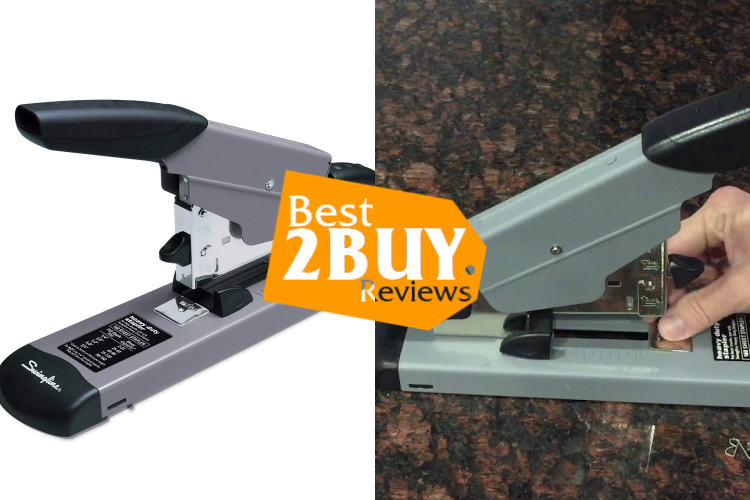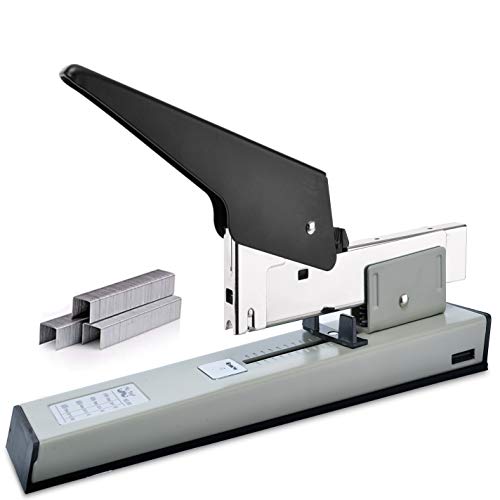The Power of Precision: A Comprehensive Guide To Heavy-Duty Staplers

- 1. The Power of Precision: A Comprehensive Guide To Heavy-Duty Staplers
- 1.1. What Is A Heavy-Duty Stapler?
- 1.2. Design and Features
- 1.3. Types of Heavy-Duty Staplers
- 1.4. Applications and Benefits
- 1.4.1. Applications
- 1.4.2. Benefits
- 1.5. Factors To Consider When Choosing A Heavy-Duty Stapler
- 1.5.1. Stapling Capacity
- 1.5.2. Staple Size and Type
- 1.5.3. Durability and Construction
- 1.5.4. Throat Depth
- 1.5.5. Stapling Mechanism and Jamming
- 1.5.6. Comfort and Ease of Use
- 1.5.7. Cost and Value
- 1.5.8. Additional Features
- 1.6. Maintenance and Care
- 1.7. Conclusion
In the world of office supplies, the humble stapler is often an overlooked hero. It’s a tool that quietly binds our papers, reports, and presentations together, providing a semblance of organization and coherence to our work. Yet, when it comes to heavy-duty tasks, regular staplers might fall short. Enter the heavy-duty stapler—a robust and powerful instrument designed to tackle larger volumes of paper with ease, precision, and durability.
What Is A Heavy-Duty Stapler?
A heavy-duty stapler is a specialized type of stapler designed to handle more substantial and demanding stapling tasks compared to standard staplers. It's constructed with more durable and robust materials, enabling it to staple through a larger stack of paper or thicker materials with greater ease.
These staplers are commonly used in settings where there's a need to staple together a significant number of papers or documents, such as in offices, print shops, schools, and other environments where high-volume stapling is required. Heavy-duty staplers typically have a higher sheet capacity than standard staplers, often able to staple anywhere from 50 to over 200 sheets of paper at once, depending on the model.
Design and Features
Heavy-duty staplers are available in a range of designs, characterized by their robust and enduring construction. Crafted predominantly from high-quality materials such as metal or heavy-duty plastic, they guarantee longevity and resilience against the wear and tear resulting from frequent use.
One of the primary features that distinguish heavy-duty staplers is their substantial sheet capacity. While standard staplers generally manage 20-50 sheets, heavy-duty versions effortlessly bind upwards of 100 sheets or more with a single clench. This significant capacity makes them the preferred choice for businesses and institutions routinely dealing with large documents.
In heavy-duty staplers, the stapling mechanism is notably superior, providing precise and powerful stapling with minimal effort. Many models incorporate leverage systems, diminishing the force required to staple large stacks of paper, thereby reducing strain on the user's hand.
Furthermore, these staplers often feature adjustable throat depths, allowing for flexibility in determining the stapling position on the paper. This capability ensures accuracy and consistency in staple placement.
Types of Heavy-Duty Staplers
Heavy-duty staplers are available in diverse types and sizes, tailored to meet distinct requirements. There are tabletop models intended for rigorous daily usage in centralized workspaces, alongside handheld variants suitable for greater mobility or occasional use. The surge in popularity of electric heavy-duty staplers has streamlined the stapling process, offering increased efficiency and ease.
Moreover, certain heavy-duty staplers are specialized for particular tasks. For example, there are models specifically designed for booklet stapling, equipped with features that facilitate precise centerline stapling, ideal for bookbinding and crafting high-quality booklets.
Applications and Benefits
Heavy-duty staplers are essential office tools for securely binding together a large number of documents, especially those with thicker stacks of paper. Here are some applications and benefits of heavy-duty staplers:
Applications
- Office Use: They are commonly used in office settings for binding reports, manuscripts, presentations, and other documents that require a more substantial and secure binding.
- Schools and Educational Institutions: Teachers, administrators, and students use heavy-duty staplers for binding together assignments, projects, and study materials.
- Publishing and Printing: In the printing industry, heavy-duty staplers are utilized for binding magazines, booklets, pamphlets, and other printed materials.
- Industrial and Manufacturing Environments: Heavy-duty staplers are used for packaging, manufacturing, and assembly of various materials that need to be securely fastened together.
- Libraries and Archives: These staplers are beneficial for binding together archival materials, creating booklets, or reinforcing book bindings.
Benefits
- Stapling Capacity: Heavy-duty staplers can handle a larger number of sheets, often ranging from 100 to 250 sheets of paper or even more, making them ideal for high-volume stapling needs.
- Durability and Sturdiness: They are designed to withstand heavy, regular usage and are typically made of more robust materials, ensuring longevity and reliability.
- Adjustable Stapling Depth: Some heavy-duty staplers offer adjustable throat depths, allowing you to set the staple position for various paper sizes and binding needs.
- Versatility: Many heavy-duty staplers can handle different staple sizes, providing flexibility in the choice of staples used for various binding requirements.
- Efficiency and Time-Saving: They save time and effort, as they can quickly bind larger stacks of paper compared to regular staplers, increasing overall productivity.
- Professional Appearance: These staplers produce more secure and neater bindings, giving documents a professional and polished look.
- Reduced Jamming: Heavy-duty staplers are less prone to jamming due to their enhanced design and robust mechanisms, ensuring smoother stapling operations.
- Ergonomics: Some heavy-duty staplers are designed with ergonomic features, reducing strain on the user's hand and making stapling large documents more comfortable.
Factors To Consider When Choosing A Heavy-Duty Stapler
To ensure you invest in a stapler that meets your specific needs and offers durability and efficiency, several factors merit consideration.
Stapling Capacity
One of the primary considerations when choosing a heavy-duty stapler is its stapling capacity. This refers to the number of sheets or thickness of materials the stapler can effectively fasten together. Heavy-duty staplers usually offer a stapling capacity ranging from 100 to 250 sheets. Assess your typical workload and opt for a stapler that can comfortably handle the volume you anticipate stapling regularly.
Staple Size and Type
Heavy-duty staplers often accommodate various staple sizes, such as standard, high-capacity, or specialty staples. Consider the staple size that best suits your needs. Additionally, some staplers allow for adjustable stapling depth, enabling you to control how far the staple penetrates the material. Understanding the type of staple and the depth required for your projects is crucial when selecting a heavy-duty stapler.
Durability and Construction
The durability and construction of a heavy-duty stapler play a significant role in its performance and longevity. Look for staplers made from robust materials, such as metal or heavy-duty plastic, to ensure reliability and longevity. Metal staplers tend to be more durable and suitable for heavy, consistent use, while high-quality plastics can also offer durability without the added weight.
Throat Depth
Throat depth is the distance from the stapler's throat (the opening where the paper is inserted) to the stapler's anvil (the metal plate that bends the staple). This dimension is critical as it determines how far into a document the stapler can reach. For larger paper sizes or more extensive documents, a longer throat depth is essential to ensure the staple is positioned correctly.
Stapling Mechanism and Jamming
The stapling mechanism can vary from one heavy-duty stapler to another. Some may use leverage, while others could employ different spring mechanisms. Look for staplers with jam-resistant technology to reduce the likelihood of staple jams, which can be time-consuming and frustrating. Opt for models with clear instructions on how to clear jams efficiently, in case they occur.
Comfort and Ease of Use
Considering the frequency of use, ergonomics and ease of operation are crucial. Look for staplers with comfortable handles, easy reload mechanisms, and a smooth operation to minimize strain or fatigue during extended use.
Cost and Value
While the initial cost is a consideration, it's essential to assess the overall value the stapler provides. A higher initial cost might be justified by greater durability, efficiency, and fewer maintenance issues in the long run. Factor in ongoing costs such as staple refills and any additional accessories required.
Additional Features
Consider any extra features that might benefit your workflow, such as a staple alignment guide, adjustable paper stoppers, or the ability to switch between temporary and permanent stapling.
Maintenance and Care
Regular maintenance is crucial to guarantee the durability and steady operation of heavy-duty staplers. Ensuring they are consistently cleaned to eliminate debris, applying occasional lubrication to moving components, and using the appropriate staple size are pivotal for preserving their peak performance.
Conclusion
Sturdy staplers exemplify the progress and creativity in office supplies. With their durable construction, ability to handle large quantities, and accurate stapling, they are an essential asset in settings dealing with substantial paperwork. Whether utilized for report binding, booklet creation, or document compilation, these staplers represent efficiency and dependability, guaranteeing seamless organizational effectiveness in any work environment.











